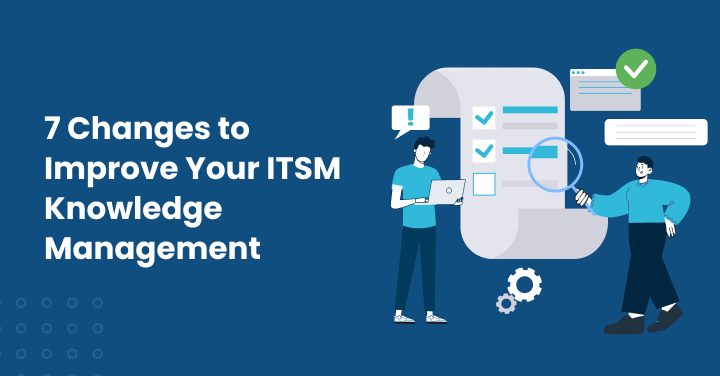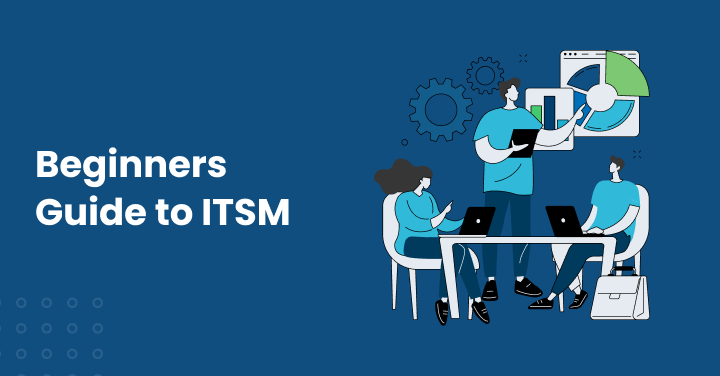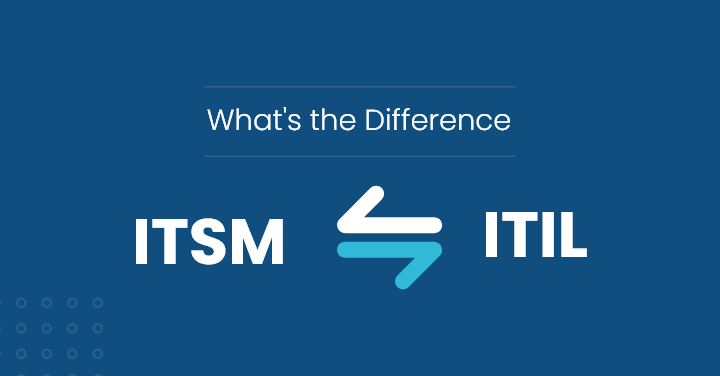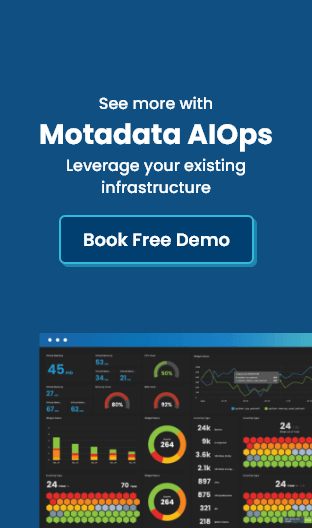In this evolving digital world, organizations that only focus on implementing new technologies will not reach the top unless they know how to manage them effectively with ITSM. IT Service Management (ITSM) is an organization’s strategic approach for designing, creating, delivering, managing, and supporting IT services.
ITSM has shaped IT operations for decades. Traditionally, it focused more on internal procedures and efficiency and less on user experience. But today, delivering a better user experience is key to achieving business success.
Modern ITSM focuses on enhancing IT service delivery, minimizing disruptions, and improving user satisfaction rather than limiting itself to IT departments and focusing on specific areas. The main goal of implementing this practice was to support organizational growth by coordinating IT services and processes with business goals.
Digital transformation has amplified the way we operate. Today, no single department can work separately, as all tasks are interdependent, raising the need for standardized service management across departments.
Further, proper collaboration between departments is essential for smooth operations. To achieve this, many organizations are implementing ITSM practices that offer automated workflows, self-service portals, and knowledge management systems to streamline processes and improve efficiency.
Let’s explore the core principles of ITSM, their benefits, and implementation strategies to help improve organizational efficiency and service delivery.
Core ITSM Principles and Their Applicability Beyond IT
One of the main reasons why ITSM is considered a potent tool for organizations is its core principles.
Here are the Core ITSM Principles:
Incident Management
Incident management is one of the core ITSM principles that offers more than fixing issues that disrupt daily operations. By implementing this idea, organizations can resolve and respond to service interruptions promptly.
For example, a customer contacted the support team to notify them about a damaged product delivery. In this case, the issue will be sent to the respective department, and a replacement will be arranged. Further, feedback will be recorded to analyze and prevent the problem from happening in the future.
Similarly, incident management can be applied to other departments, such as HR for payroll system outages or facilities teams to maintain a comfortable work environment. A structured approach to issue resolution will help reduce response time and enhance service quality.
Service Request Management
Small businesses and large organizations may encounter various customer requests daily. Rather than just handling these issues, service request management enables IT staff to follow a repeatable procedure to handle matters efficiently and save time.
For example, the HR department receives several employee requests related to policies, procedures, and benefits. By implementing service request management in the HR department, you can respond quickly and consistently, track issues, and maintain a standardized process for handling employee queries, eventually saving time.
Further, by implementing a central system, like a service catalog, employees can quickly request support and services, thus offering transparency and speeding up the entire process.
Change Management
Technologies are evolving, and so are the methods to perform operations. Hence, adapting to change is a necessity. Whether your organization plans to modify the existing policy or finance regulations, implementing ITSM’s change management principles can greatly benefit.
These principles ensure all risks are correctly assessed and changes are well-planned and communicated across teams for a smooth transition and minimal disruption. Organizations that aren’t adapting to this practice for the future may find it hard to keep up with the growing business competition.
Knowledge Management
Knowledge management is a multidisciplinary approach that many organizations are incorporating to attain business goals. This ITSM principle offers a smart way to store and share department insights.
With digital transformation, services are becoming more complex and demand proper expertise to handle challenges.
Using this strategy, IT teams can gain more information on technologies and procedures essential for quality service delivery and user experience. For example, if your software developers get stuck in some code or other crucial area, knowledge management will provide content at their fingertips, thus saving time.
A sound knowledge management system in your organization can enable team members to resolve issues faster by using the knowledge base. Further, these self-service resources create a culture of learning and growth and improve connections between internal and external personnel.
Problem Management
The problem management principle is not limited to finding and resolving issues. It works to find the actual cause behind the instance and fix it in real time to prevent it from recurring in the future. Even a minor fault in an application or network can affect different components and areas. By identifying and eliminating the root cause of the problem, you can change how other things run in the organization and prevent more customer complaints.
For example, if a constant issue is reported related to processing employee benefits claims to HR, this practice can help find the area causing the delay and make improvements.
Departments Benefiting from Extended ITSM
Implementing IT service management (ITSM) practices has many benefits, which is why many departments use them to achieve organizational goals. Let’s understand these benefits in detail.
Human Resources (HR)
Human Resources (HR) is essential in an organization as they are responsible for employee management, recruitment, consultation, etc. When a new employee joins an organization, HR must ensure all the employee’s accounts and credentials are correctly set up. By having ITSM in place, the onboarding and offboarding processes are well-structured, making it easier for the HR departement to automate tasks, ensure proper data collection from new employees, and leave employees to have their access revoked systematically.
Additionally, ITSM enables HR teams to handle employee queries and track resolution status from a centralized system. It also supports policy and compliance management by automating workflows and ensuring efficient data record management.
Facilities Management
Facilities Management is another department that can make the most of its services by enabling ITSM integration. This department plays an essential role in overseeing physical resources and service requests.
Using ITSM software, the department can perform asset tracking and request management more efficiently. For example, a report can be created and forwarded to the respective department through a streamlined system if there is a fault in the AC. A quick action or replacement will be made, which can be easily tracked through the service request status.
Space management and resource allocation are also enhanced, allowing office spaces, meeting rooms, and other facilities to be used to their full potential. In addition, ITSM streamlines the process of granting and revoking access to IT resources and digital assets, enhancing security and access control and resulting in a secure work environment.
Customer Service
Customer Service teams leverage ITSM to optimize customer support workflows and deliver quality experiences. Addressing all issues promptly and systematically is essential to achieving this. By integrating ITSM with Customer Relationship Management (CRM) systems, team members can better track customer queries, assign them, and resolve them in real time. Thus, they can reduce response time and ensure that the team misses no request. By maintaining consistent and high-quality customer experiences, organizations can build long-term customer trust and relationships.
Finance
Finance departments also benefit from ITSM in multiple ways. IT service management (ITSM) implementation in the finance department helps streamline workflows and boost collaboration with other departments. Further, the management of procurement requests becomes more structured, allowing team members to seamlessly track approvals, purchases, and interactions with vendors. Automating workflows further eliminates manual errors in expense reporting and approvals.
With ITSM practice in finance, audit and compliance tracking becomes more manageable, allowing finance workers to focus on other areas such as financial management and analysis.
Legal
ITSM’s principles can help the legal department manage its workflows and contracts better. Team members can keep a well-organized record of their agreements and contracts, allowing them to access information faster when needed. Further, the ticketing system speeds up the legal request process or any obligation reported against legal papers in real time.
The legal department can further track legal inquiries, cases, and documentation from a central system. Additionally, ITSM enhances compliance management, as it helps legal teams monitor regulatory changes, implement necessary policy updates, and ensure that the organization remains compliant with industry laws and standards.
Implementation Strategies and Best Practices
A well-planned strategy that aligns with business needs is essential for implementing an effective IT Service Management (ITSM) framework. Organizations must implement best practices and strategies for continual improvement and business success.
Selecting the Right ITSM Tool
Investing in the right ITSM tool that fulfills the business’s needs and provides customer satisfaction is essential to improve your service management capabilities. Ensure your selected ITSM tool is scalable and flexible, i.e., able to evolve with IT requirements and grow with the business. A scalable solution will enable businesses to expand their ITSM framework without stressing over service disruptions.
Additionally, check if it supports integration with third-party tools and existing IT infrastructure or applications. A well-integrated system can help exchange data seamlessly. Further, ensure it has a user-friendly interface, thus allowing employees from different departments and with less expertise to easily navigate and make the most of it without extra effort.
Adapting ITSM Processes
To get the maximum out of ITSM tools, businesses must adapt workflows to meet the specific needs of different departments. Standardized ITSM frameworks may not always meet particular operational needs; hence, flexibility is essential. Customizing workflows allows team members to efficiently address other challenges for each department while maintaining overall coherence within the IT service strategy. Additionally, ITSM processes should align with broader business objectives for enhanced service delivery.
Change Management and Communication
Managing change in the IT sector is not as easy as it sounds. Existing employees might resist adopting new tools or IT processes due to their complexity or disruption in daily tasks. To convince or address resistance, organizations must initially communicate the need for change with their employees and stakeholders. This discussion might help employees understand how implementing ITSM can reduce their workload and eliminate human error responsible for downtime. Change management strategies should also include feedback mechanisms to identify and address concerns promptly.
Training and Education
Even if your employees agree to adopt new tools and business processes, providing them with comprehensive training for quality results is essential. Department-specific training will clarify their roles and enable users to leverage ITSM capabilities. Also, fostering a service excellence culture encourages employees to prioritize customer satisfaction and continuous improvement. By promoting knowledge sharing, organizations can build a workforce that aims to deliver quality customer services.
Metrics and Measurement
Organizations must establish key performance indicators (KPIs) aligning with service objectives to assess how well ITSM implementation works. Examples include response times, issue resolution rates, and user satisfaction levels. Monitoring service level agreements (SLAs) is equally crucial since it guarantees that IT services fulfill predetermined performance criteria.
Furthermore, continual service improvement (CSI) is an ongoing process that enables organizations to refine their ITSM framework based on business performance insights. Regular risk assessment, performance data analysis, asset management tracking, etc., can help businesses sustain operational efficiency.
Conclusion
With digital transformation, it has become necessary for organizations to adopt ITSM practices. The modern Information Technology (IT) sector has various complexities and challenges that the traditional ITSM framework cannot overcome. Further, AI, Machine Learning, and automation are transforming ITSM by reducing manual intervention. Now, AI-driven chatbots streamline service requests, and predictive analytics can manage potential issues. With automated workflows, you will face fewer issues in resolution time, ensure consistent service delivery, and have a better user experience across different departments.
Some organizations also switch to Enterprise Service Management (ESM) for seamless integration, centralized service management, and improved collaboration. Implementing ITSM strategy will be challenging, but adhering to best practices and techniques and committing to ongoing improvement can ensure long-term success. So, invest in ITSM Software like Motadata to streamline your business processes.
FAQs:
ITSM, or IT Service Management, emphasizes managing IT services within an organization. ESM, or Enterprise Service Management, is a broader concept that includes managing services across all departments and business functions within an organization rather than just focusing on IT tasks.
Using ITSM across different departments can improve efficiency and standardize service delivery. Further, incorporating ITSM tools will enable employees to manage tasks better and synchronize with other departments.
Artificial Intelligence (AI) will automate routine tasks and reduce waiting time, eventually improving the end user experience. Further, with predictive analytics, team members can make accurate decisions.









